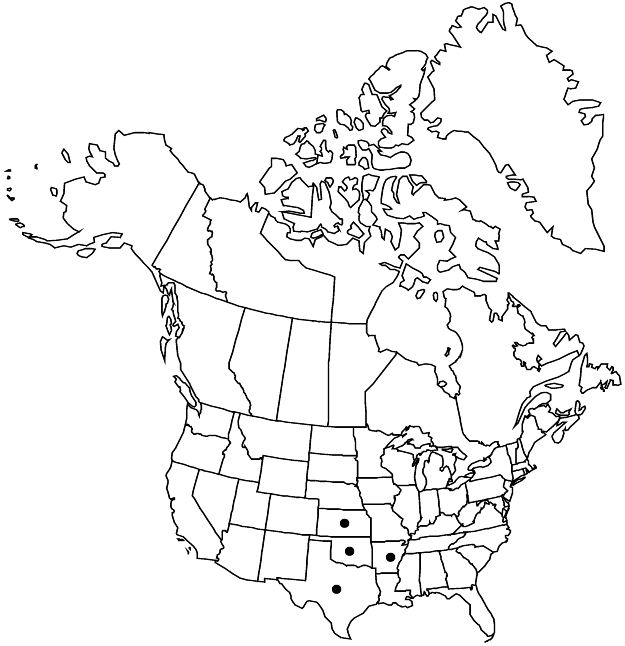Difference between revisions of "Euphorbia longicruris"
Linnaea 22: 152. 1849.
FNA>Volume Importer |
imported>Volume Importer |
||
| (6 intermediate revisions by 2 users not shown) | |||
| Line 16: | Line 16: | ||
|name=Tithymalus longicruris | |name=Tithymalus longicruris | ||
|authority=(Scheele) Small | |authority=(Scheele) Small | ||
| + | |rank=species | ||
}} | }} | ||
|hierarchy=Euphorbiaceae;Euphorbia;Euphorbia subg. Esula;Euphorbia longicruris | |hierarchy=Euphorbiaceae;Euphorbia;Euphorbia subg. Esula;Euphorbia longicruris | ||
| Line 31: | Line 32: | ||
|elevation=300–800 m. | |elevation=300–800 m. | ||
|distribution=Ark.;Kans.;Okla.;Tex. | |distribution=Ark.;Kans.;Okla.;Tex. | ||
| − | |discussion=<p>Euphorbia longicruris is quite similar to the other small, annual members of subg. Esula in the south-central United States and can best be distinguished from those species by its imbricate dichasial bracts that form little tufts of overlapping leaves at the ends of the pleiochasial branches.</p> | + | |discussion=<p><i>Euphorbia longicruris</i> is quite similar to the other small, annual members of subg. Esula in the south-central United States and can best be distinguished from those species by its imbricate dichasial bracts that form little tufts of overlapping leaves at the ends of the pleiochasial branches.</p> |
|tables= | |tables= | ||
|references= | |references= | ||
| Line 40: | Line 41: | ||
-->{{#Taxon: | -->{{#Taxon: | ||
name=Euphorbia longicruris | name=Euphorbia longicruris | ||
| − | |||
|authority=Scheele | |authority=Scheele | ||
|rank=species | |rank=species | ||
| Line 55: | Line 55: | ||
|publication year=1849 | |publication year=1849 | ||
|special status=Endemic | |special status=Endemic | ||
| − | |source xml=https:// | + | |source xml=https://bitbucket.org/aafc-mbb/fna-data-curation/src/2e0870ddd59836b60bcf96646a41e87ea5a5943a/coarse_grained_fna_xml/V12/V12_350.xml |
|genus=Euphorbia | |genus=Euphorbia | ||
|subgenus=Euphorbia subg. Esula | |subgenus=Euphorbia subg. Esula | ||
Latest revision as of 19:14, 5 November 2020
Herbs, annual, with taproot. Stems erect, usually unbranched, occasionally branched later in season, 5–25 cm, glabrous. Leaves: petiole 0–0.5 mm; blade cuneate-spatulate to obovate, 5–15 × 2–6 mm, base broadly attenuate, margins entire, apex rounded to obtuse, mucronate, surfaces glabrous; venation pinnate, midvein prominent. Cyathial arrangement: terminal pleiochasial branches 3, each many times 2-branched; pleiochasial bracts obovate, similar in size to distal leaves; dichasial bracts basally subconnate, strongly imbricate and often obscuring internodes, reniform to semiorbiculate, base cordate, margins entire, apex rounded; axillary cymose branches 0–5. Cyathia: peduncle 0.3–0.5 mm. Involucre campanulate, 1.5–2 × 1–1.5 mm, glabrous; glands 4, crescent-shaped to elliptic, 0.4–0.8 × 0.8–1.1 mm; horns divergent, 0.5–0.8 mm. Staminate flowers 10–15. Pistillate flowers: ovary glabrous; styles 0.5–0.6 mm, 2-fid. Capsules ovoid-globose, 2–2.8 × 2.5–3 mm, 3-lobed; cocci rounded, smooth, glabrous; columella 1.6–2.1 mm. Seeds gray to purple-gray or sometimes nearly black, oblong, 1.3–1.6 × 0.9–1.2 mm, strongly small-pitted; caruncle umbonate, depressed-conic, 0.5 × 0.7 mm.
Phenology: Flowering and fruiting spring.
Habitat: Grasslands, open prairies, sites with rocky, usually calcareous soils.
Elevation: 300–800 m.
Distribution

Ark., Kans., Okla., Tex.
Discussion
Euphorbia longicruris is quite similar to the other small, annual members of subg. Esula in the south-central United States and can best be distinguished from those species by its imbricate dichasial bracts that form little tufts of overlapping leaves at the ends of the pleiochasial branches.
Selected References
None.